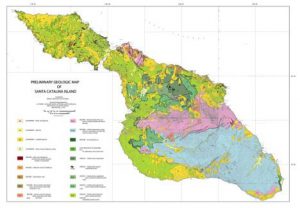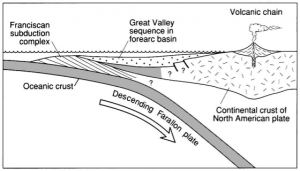
Time to turn back the clocks…to 100 million years ago! Catalina Island was formed from geological events back in the Mesozoic era when dinosaurs still roamed the Earth. The beautiful flora and fauna of Catalina Island sit on two main types of rock: igneous and metamorphic. Igneous rock is the younger of the two because it is produced from direct volcanic activity. Metamorphic rock is formed from different rocks that are subjected to various amounts of heat and pressure in the Earth’s crust. Catalina’s metamorphic rock, Catalina Schist, is found nowhere else in the world and is observed on the west end of the island.
 Geological map of Catalina Island Green and yellow = metamorphic rock; Blue and pink = igneous rock
Geological map of Catalina Island Green and yellow = metamorphic rock; Blue and pink = igneous rock
Photo credit: Catalina Island Conservancy
Catalina Schist took approximately 80 million years to form underneath the ocean’s surface as a part of violent tectonic plate activity. Three plates in the crust—North American, Farallon, and Pacific—were responsible for many of the geological features in the Channel Islands and United States west coast. As the Pacific Plate began to migrate eastward, it crushed the Farallon Plate against the North American Plate. Because the Farallon Plate was a heavy oceanic plate it sank underneath the lighter continental North American Plate, creating a subduction zone.
Heat and pressure resulted from the two plates grinding against each other for millions of years and subsequently created different kinds of metamorphic rocks. Some of these rocks formed the Rocky Mountains and Sierra Nevadas, and some bundled together to form a mélange of rocks that became the Channel Islands. The Farallon Plate eventually broke apart under the movement of the massive Pacific Plate and is now part of the Earth’s crust near Kansas! Geologic activity that produces mountainous regions is called regional metamorphism, and the Channel Islands are an excellent showcase of this process.
Formation of Catalina Island caused by colliding crust and subduction zones
Photo credit: Wikipedia (Franciscan Assemblage)
Catalina Schist was formed about 15-30 km deep in the Earth’s crust under a medium pressure and medium temperature. There are three subtypes of Catalina Schist: garnet amphibolite, greenschist, and blueschist. Geologists determine a rock’s history and origin by looking at its crystals; how the crystal is aligned, its age, and shape will reveal the temperature, location, and conditions under which the rock was formed. During the Farallon subduction, some parts of the crust experienced more heat than others, resulting in different kinds of schist. Schist can be differentiated from other types of metamorphic rocks using the following factors:
- Schistosity: the degree of folding and crystal alignment in a rock
- Hardness: how much force a rock can undergo before its structure is compromised
- Melting point: at which temperature the rock begins to disintegrate
- Crystal structure and orientation
- Grain coarseness: whether rocks appear grainy or solid

Blueschist and other metamorphic rock found near Echo Lake on Catalina Island
Photo credit: Alyssa Bjorkquist
Catalina Schist is unique is found in an inverted temperature gradient, meaning that the rocks formed under hotter temperatures are found closer to the surface and cooler rocks are found deeper. Garnet amphibolite is the youngest of the Catalina schists. It is usually coarse and grainy, has bright chunks of garnet embedded in the rock, and has little to no schistosity (folding and flakiness). It is formed when exposed to an average temperature of 620ºC and was the first of the Catalina Schist to rise out of the water. Greenschist is formed around 400ºC, exhibits a high degree of schistosity (high degree of folding and flaking), and has an abundance of serpentine in the rock, giving rise to its green color.
 Blueschist is one of the rarer types of rock in the world due to its unique conditions during formation. Below the Earth’s crust at 15-30 km, the temperatures are normally a sweltering 500-750ºC. However, when rocks sink rapidly below a neighboring tectonic plate in a subduction zone the temperatures can change dramatically. Blueschist forms when metamorphic rock is quickly shoved underneath a tectonic plate, heated up to 200-400 ºC (the temperature of your average cooking toaster), then brought up to the top of the crust before the entire rock has time to cool completely. This high-pressure/low-temperature situation in combination with rocks subducting and rising creates a special formation called a Franciscan series, a collection of accretionary wedges like Catalina Island that exemplify West Coast geology.
Blueschist is one of the rarer types of rock in the world due to its unique conditions during formation. Below the Earth’s crust at 15-30 km, the temperatures are normally a sweltering 500-750ºC. However, when rocks sink rapidly below a neighboring tectonic plate in a subduction zone the temperatures can change dramatically. Blueschist forms when metamorphic rock is quickly shoved underneath a tectonic plate, heated up to 200-400 ºC (the temperature of your average cooking toaster), then brought up to the top of the crust before the entire rock has time to cool completely. This high-pressure/low-temperature situation in combination with rocks subducting and rising creates a special formation called a Franciscan series, a collection of accretionary wedges like Catalina Island that exemplify West Coast geology.

Three types of Catalina Schist, found with an inverted temperature gradient and increasing schistosity.
Left to right: garnet amphibolite, green schist, blue schist
Photo credit: Alyssa Bjorkquist
To learn more about Catalina’s geology and the types of rocks found here, explore the Catalina Island Conservancy website: https://www.catalinaconservancy.org/index.php?s=news&p=article_322
To learn more about schist, shale, and metamorphic rocks, click here: http://geology.com/rocks/schist.shtml
To learn more about blueschist and hear interesting podcasts on work being done by the U.S. Geological Survey (USGS), follow this link: https://walrus.wr.usgs.gov/infobank/programs/html/school/moviepage/17.01.28.html
Written By: Alyssa Bjorkquist
Sources
- Allan A. Schoenherr, C. Robert Feldmuth, and Michael J. Emerson. 1999. “Natural History of the Islands of California”. University of California Press, Berkeley and Los Angeles, CA.
- Chris Pellant. 2002. “Smithsonian Handbooks: Rocks and Minerals”. Dorling Kindersley Limited, London, United Kingdom.
Images
- Catalina Island Geological Map: https://www.catalinaconservancy.org/userfiles/images/island_naturalist/October%202013/Geologic%20Map.jpg
- Subduction Zone Diagram: https://en.wikipedia.org/wiki/Franciscan_Assemblage#/media/File:Franciscan_subduction_model.gif


